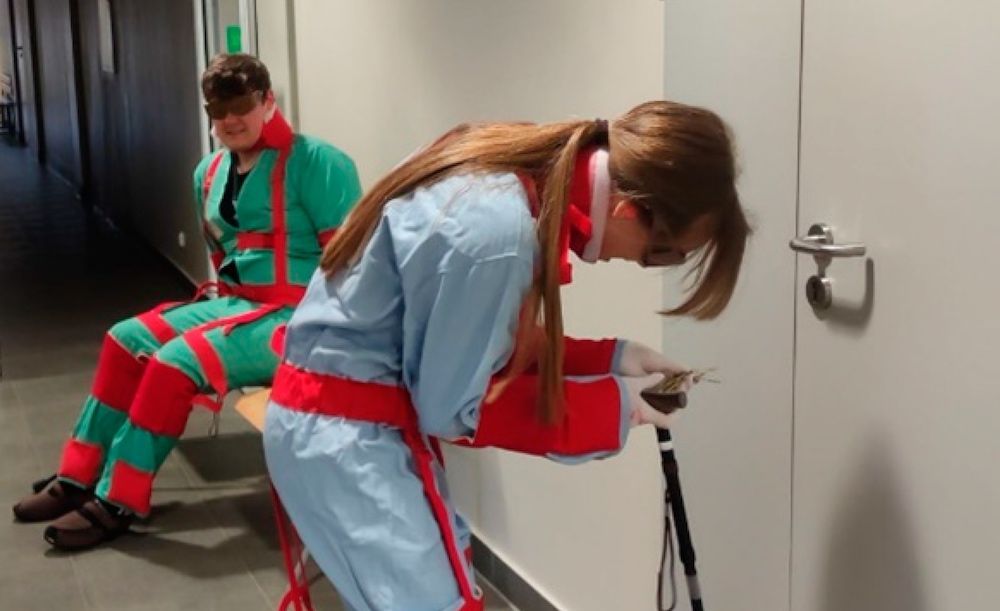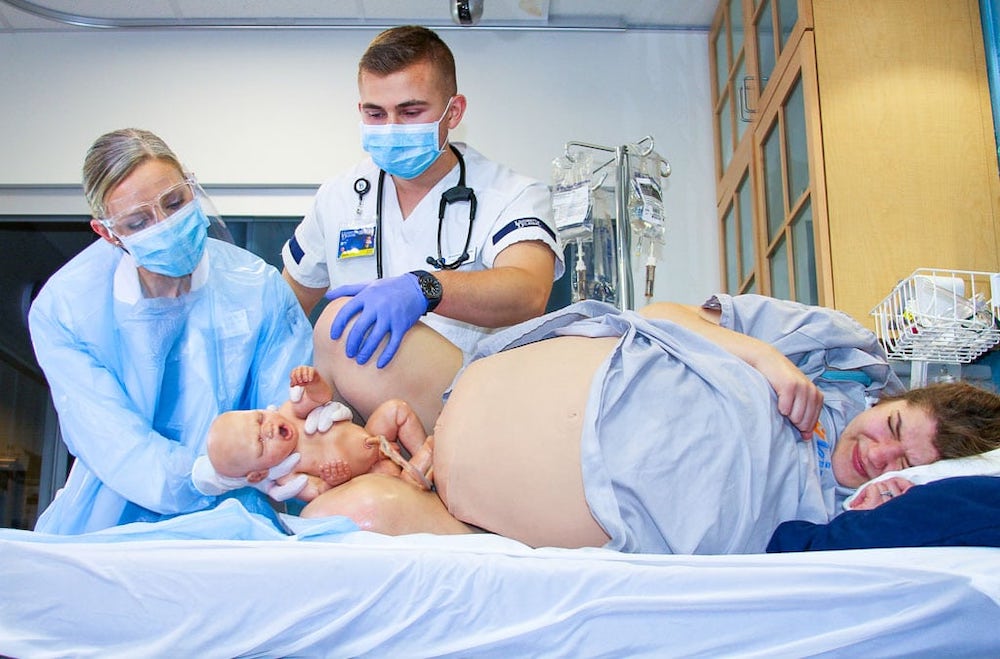One of the goals of clinical simulation is to replicate the human patient, environment, and situation for healthcare participants to improve patient care and outcomes. Hybrid simulation is one way to increase the simulation scenario realism. The Healthcare Simulation Dictionary (Lioce et al., 2020) has defined hybrid simulation as – most commonly applied to the situation where a part-task trainer is realistically affixed to a standardized/simulated patient, allowing for the teaching and assessment of technical and communication skills in an integrated fashion (pg. 22) (Kneebone, Kidd et al., 2002). Defining Excellence in Simulation Programs describes wearable simulators as products “designed with interactive technology and realistic anatomy and physiology to replicate associated patient care.” The goal of this HealthySimulation.com article is to explore the ways wearable simulators can improve a healthcare simulation program.
Technical Skills Can Be Taught Realistically
Clinical educators have known the ability to be a competent healthcare provider requires the technical ability to perform the skills and the ability to talk with, educate, and empathize with patients. Every simulation educator has heard a healthcare student state, “If it were a real person, not a plastic manikin, I would have said this or done that. Wearable simulators allow clinical professional learners the ability to practice the skill while communicating with the standardized/simulated patient. The incorporation of wearable simulators and human beings is considered by many to be the highest type of fidelity available to educate healthcare learners. Some of the products are available to be worn by a standardized or simulated patient to allow the technical skills to be performed while interacting with a human. The wearable simulators allow the healthcare participant the opportunity to practice:
- Foley catheter
- Tracheostomy care
- Birthing
- Intravenous stick with and without ultrasound
- Central venous catheter line insertion and/or site care
- Cardiac and Respiratory auscultation sounds
- Chest tube care
- Chest overlay for ultrasound-guided puncture and thoracentesis
- Various wounds for burns, pressure ulcers, and bleeding traumatic injuries
- Lacerations requiring sutures
- Skin locations for a parental injection
Some of these have embedded sensors or wearable wireless sensors that can send cues to the standardized/simulated patient when and how to respond to the patient. An example of a sensor is the wearable tracheostomy. When the healthcare provider suctions the tracheostomy patient, a chest plate sensor vibrates when a predetermined pressure threshold is met to cue the patient to start coughing. This increases the realistic experience for the healthcare provider on how a patient will react versus performing the procedure on a plastic manikin.
View the LEARN CE/CME Platform Webinar Getting Started with Interprofessional Simulation to learn more!
Real Opportunity to Practice Patient Empathy
Other wearable simulators can help teach empathy to healthcare learners. Empathy can be obtained through communicating with the patient during a procedure and by wearing a simulator to have the lived experience with a condition, diagnosis, or age-related limitations. Some of these can be worn by the learner to experience limitations while performing tasks and activities of daily living. Some examples of the wearable simulators are:
- Pregnancy abdomen and breast for size and weight limitation
- Geriatric mobility suit for physical limitations in tasks and activities performance
- Obesity suit to limit movement
- Vision loss glasses to limit sight in specific visual fields
- Vision distortion glasses
- Partial headphones/earplugs for distorted hearing
- Hemiplegia restriction bands limit movement on one side of the body
- Gloves with cotton balls in fingertips and tape to joints for arthritis and decreased touch perception
- Breastfeeding to learn how to hold an infant and teach new breastfeeding mothers
Communication Skills in Real Life
The most common cause of medical error is rooted in communication. Traditionally, healthcare students learn the technical skills on a plastic manikin while participating in one-way communication. This differs from how the skill will occur in the traditional clinical setting. Healthcare professionals must learn to communicate clearly, accurately, and realistically in our healthcare system. Some of the techniques that can be practiced with wearable simulators and standardized/simulated patients are:
- Talk to the patient during a procedure
- Provide comfort with pain
- Educate and reassure patient during a technical skill performance
- De-escalation of feelings during technical skills
Silicon Masks to Simulate Geriatric Care
Kerry Reid-Searl, PhD, MClin Ed, BHlth, Sc., introduced many simulation educators to the use of a silicone geriatric mask incorporation into building a standardized patient persona for students to learn to care for the geriatric patient. The company Mask Ed would train individuals or educators to become a geriatric patient. Each person trained would be fitted for a mask as part of their geriatric patient. Now, these masks can be purchased through multiple companies. These masks are extremely realistic, especially when fitted to the person. This allows learners to interact with a geriatric client to experience how to care for a person experiencing some of the changes that traditionally occur with age. Some of these changes are slower reaction time, softer speech, shuffled gait, and interactions that require additional time to communicate.
The students learn the positive and negative consequences of how to communicate and interact with geriatric clients. When allowed time to speak and perform simple tasks. When rushed to perform a task or talk, the geriatric patient can become agitated, anxious, and confused. This allows the learner to develop compassion and empathy for the geriatric client while providing better care to the client.
Wearable Simulator Companies
Several companies have developed and sell wearable simulators. Some of these companies also offer training to the Standardized Patients to learn to provide better cueing with the wearables. Some of the companies that develop and/or sell wearable simulators include:
- Avkin
- Extreme Simulations
- Pocket Nurse
- TraumaSIM
- Reality Works
Wearable simulators have made a significant contribution to the healthcare simulation community to improve the educational experiences of our students. As simulation educators, remember to use the most appropriate modalities to provide the highest-quality experiential learning opportunities to their learners for better outcomes.
Learn More About Wearable Simulators and How They Impact Simulation!





